For track cycling, the Olympics began a year ago in Glasgow. The 2023 world championships were not just a handy chance to survey the competition, but also to get a good stickybeak at all the technical innovations they’d be up against come Paris 2024.
As per regulations set by the sport’s global governing body, the Union Cycliste Internationale, all new equipment to be used at an upcoming Olympics must be presented and used at an international competition at least 12 months before the Games. Naturally, most national federations and manufacturers generally wait until the last possible moment to let rivals in on whatever secrets they have spent the previous few years developing. In this case, the latest available option within the rules was last August at the Sir Chris Hoy Velodrome.
“Glasgow was that big moment where everyone had to show their hand a little bit,” says Paul Collins, AusCycling’s director of engineering excellence. “So at Glasgow, there were a whole heap of people looking at each other, taking photos, sending WhatsApp messages. Then you go onto the social media pages and specialist news websites, and review what’s been presented.”
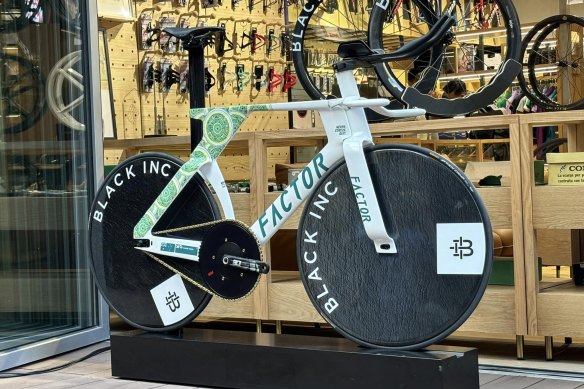
The Australian track bike built by Factor that will be used in Paris. Credit: Facebook/Factor
In all, there were almost 400 new components: frames, wheels, clothing, helmets, you name it. Team GB dropped the second-generation Hope-Lotus superbike that starred at the Tokyo Games, this time with serrated front forks apparently inspired by fighter jets, among other revisions to the seatpost and handlebars. Japan debuted their Bridgestone bike, developed in collaboration with Japanese carbon-fibre manufacturer Toray, and France unveiled the Look P24 bike they hope will deliver results at a home Games.
Each country pored over the others’ specs in minute detail, predicting what might offer the key marginal gain to deliver gold at the velodrome in Paris this week. The sheer depth of analysis would boggle the minds of most laypeople. For cycling nerds, it is an aerodynamic paradise – the latest acquisitions in an arms race that has propelled well-funded national teams to new frontiers each Olympic cycle.
Australia’s latest creation is the result of a partnership between AusCycling and Factor Bikes, with input from experts who work with Formula One, World Tour road cycling and in the aeronautical industry. The bike, designed specifically for pursuit racing, features extreme forks, customised 3D-printed titanium aerobars and specialised wheels.
Yet none of these elements are the most striking factor. The thing that most caught the eye when the bicycle went on the market in January was the eye-watering price tag. Retailing at $US59,999 ($93,800), it might have been just about the most expensive bike in the world.
The reason for the astronomical hike has less to do with the actual apparatus and more to do with keeping it away from rivals. The UCI’s other key rule, designed specifically to control the one-upmanship, requires teams to use only commercially available equipment “that is sold for use by anyone practising cycling as a sport”.
So Factor put its new bike on sale, with a price tag it felt sure would deter any rivals tempted to purchase it, too. “Obviously, this bike was produced solely for the Australian Olympic team,” says Factor chief executive Rob Gitelis. “So in order to prevent any other teams from buying that, we put that extraordinary price on it so that nobody would dare to purchase one.”
Gitelis says not even uber-wealthy amateurs have dared – no commercial orders have been placed to date.
The post-Games plan, he clarifies, is to lower it so it is “priced fairly similarly to our other bikes”, most of which retail between $10,000 and $15,000.
Australia will soon know for sure if it was worth the time and money. This week, all the top nations will find out where they stand in the ultimate field of tech warfare, which has sent world records tumbling for almost half a century.
The importance of technology has always made cycling a bit different from most other summer Olympic sports. There are a few exceptions, such as sailing and rowing, but the majority of medals go to athletes who can run and swim the fastest, jump the highest and farthest, lift the most, or score the most goals. These are all predominantly functions of the body, with the athlete at the centre.
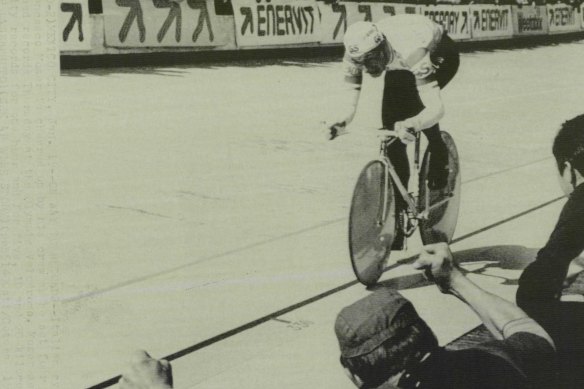
Italian cyclist Francesco Moser on his record-setting ride in 1984.Credit: AP Laserphoto
Cycling – both on the track and road – has existed in a unique space since the birth of the modern Olympic movement, but for about 70 years the evolution of the bicycle was incremental and mostly revolved around improvements to gears and brakes. Then, in 1984, Francesco Moser changed everything. Moser, an Italian road racer who was also an accomplished track cyclist, broke the prestigious hour record – the longest distance a cyclist can cover over 60 minutes, alone on the track from a stationary start.
It wasn’t just that he covered 51.151km, it was that he did it on a silver dream machine with disc wheels. Eddy Merckx, the Belgian nicknamed “The Cannibal” who had set the previous record of 49.431km in 1972, had done so on a conventional bike. The man who built it, Ernesto Colnago, believed at the time that lighter equalled faster, and had even inflated Merckx’s tyres with helium. But the engineers behind Moser’s bike turned that theory on its head by prioritising aerodynamics over weight.
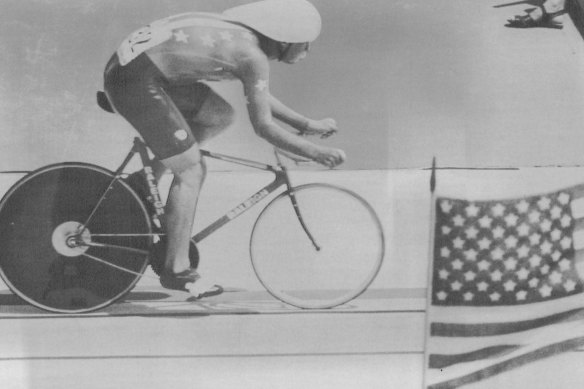
On an outside velodrome track at the 1984 Olympics, American Steve Hegg won gold in the 4000-metre individual pursuit on a bike worth more than $US35,000 – the price at the time of a new Mercedes-Benz.Credit: Fairfax Media
The disc wheels disrupted the status quo and ushered in a decade of innovation free from the shackles of traditional thinking. Speedy “funny bikes” with smaller front wheels (named after their drag racing “funny car” counterparts) became the time trial norm, and were used to notable success by the US Olympic team at the 1984 Olympics in Los Angeles. English cyclist Chris Boardman turned up to Barcelona 1992 with the original Lotus bike – the Type 108 featuring a monocoque carbon frame with one fork blade in a Z-shaped design – and won Britain’s first Olympic cycling event in decades with 4000m individual pursuit gold.
Another chief agent of change was Graeme Obree, an unemployed amateur who twice broke Moser’s hour record in 1993. Obree, nicknamed “The Flying Scotsman”, made his own bicycles at home, and fashioned the unorthodox “Old Faithful” from scrap metal and washing machine bearings. More radical still was the “tuck” or “crouch” position he adopted: arms folded into his shoulders, elbows tight to his sides, chest on the handlebars and chin over the front wheel.
“It’s almost like he’d have the old drop handlebars from a normal road bike, turn them up, and then just lean his chest onto the handlebars,” says Australian former Olympic gold medallist Scott McGrory.
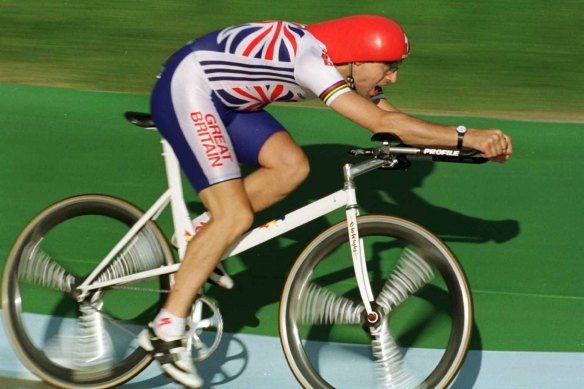
Graeme Obree in his Superman position at the Olympic Velodrome at Stone Mountain, Georgia, in 1996.Credit: Getty Images
Obree’s use of the tuck position to win the 1993 individual pursuit world title did not please the UCI, which promptly banned it. Obree returned with a new riding stance, nicknamed “the Superman” for its outstretched-arms pose. The UCI banned that, too. But not before he regained the hour record in 1994, having lost it to Boardman in 1993 – a week after breaking it the first time.
In 1997, the UCI went further and banned the flurry of hour records set on bikes with technological advantages (Boardman broke it again in 1996 with the Superman). Under the new rules, Merckx’s 1972 record wasn’t broken until 2000.
“Basically, he was seen as a weirdo who was bringing the sport into disrepute because of the bike, and because the [tuck] position was just so extreme,” McGrory says. “But everyone adopted the Superman position. When he raced against Chris Boardman at events, Boardman himself was riding the position. Even my Australian Olympic teammates, Brett Aitken and Dean Woods, were racing national championships on bikes in that Superman position until that got banned as well.”
Obree’s exploits and the arms race of the ’90s hardened the UCI’s abhorrence of novelty to such an extent that it formalised its traditional values in the form of the Lugano Charter. The 1996 rule book was designed to uphold the organisation’s purist ideals about the spirit of cycling as a sport of athletes, not equipment. And, by setting parameters for the size and shape of frames and other parts, essentially stipulated that bikes must look like conventional bikes and equipment must be available to all competitors. That meant no one-offs and no prototypes.
“We could have faster bikes now, but the UCI brought in the regulations to take it back to the pure nature of cycling – or at least make the bikes look as if the bike’s just a little bit more advanced than what they were in the ’60s,” says McGrory, who now works as a cycling commentator.
“Obree is incredible, what he did. Really quirky guy, that’s why he came up with these ideas and was thinking outside the box. Whereas now, we don’t have the quirky people doing it. It’s the Formula One engineers and aerodynamicists and the scientists and sports scientists – they’re the ones trying to get those marginal gains and one-percenters for our current athletes.”
Amendments have been made to the text of the Lugano Charter over the years, but it is still in place. Some of the rules are explicit, and some are more vague, meaning thinking outside the box has become an exercise in identifying loopholes and jumping through them before anyone else does.
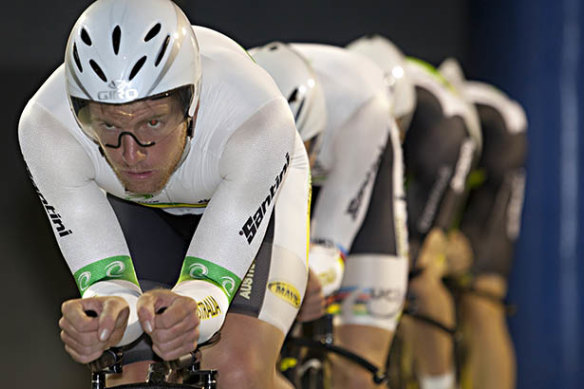
Australia’s London 2012 men’s pursuit team of Glenn O’Shea, Rohan Dennis, Michael Hepburn and Jack Bobridge conducting wind tunnel analysis before the Games. They took silver behind Great Britain.Credit: Australian Sports Commission
The advantage now is that experts have access to wind tunnels – an accurate method of aerodynamics testing scarcely used back when Obree was pulling apart an old washing machine under the influence of intuition alone. (In 2018, Obree tested a replica of “Old Faithful” in the Mercedes F1 team’s wind tunnel to gauge the aerodynamic efficiency of his various riding positions on the bike. The tuck was significantly more efficient than the conventional 1990s riding position; the Superman only marginally so.)
But much inspiration is still derived from observation and imitation. From minor tweaks to full blueprints, you can guarantee the hottest new thing from one Olympics will spawn similar-looking versions across the field at the next. The obvious example is Britain’s Hope-Lotus, which debuted in Tokyo to great fanfare over its ultra-wide forks. “It almost doesn’t look like a bicycle,” says Australian sprint star Matt Richardson, who will push for individual and team gold in Paris.
“If it didn’t have two wheels on it, you would be like, ‘what is that?’ It piqued interest, and people started developing and researching that sort of bike design,” says Richardson. “Now, for this Olympics, there’s like six bikes that have a very, very similar design. You can pretty much bank on whatever the British do – they know what they’re doing.”
Science aside, the ceiling on what can be achieved is almost always dictated by money, and the national teams with the most financial power naturally have access to the best gear. Winning hosting rights to a Games often elicits welcome windfalls from governments. As a general rule, however, developed countries have more to spend than their developing counterparts.
“I was trying to find out some tech budgets for the teams – they’re all behind NDAs [non-disclosure agreements],” Australian former track and road cyclist Katherine Bates said on The Wheelhouse Cycling Podcast in February. “But it is big money. Each of these bikes costs – if you look at the big costs with all the components – around $60,000 plus or minus some more. And the research and development to even get to that point is just phenomenal.”
That in itself asks big ethical questions about inequality and inaccessibility. “It’s a major concern in terms of availability and equity,” Bates said. “We had a couple of riders [at the 2024 UCI Track Nations Cup in Adelaide] from less-developed cycling nations who were riding bikes that are commercially available, but might come in at around $5000 to $6000, versus the $65,000-plus the R&D [research and development] budget that’s been put into it. So it’s a massive issue, and this is what the UCI tech regs around ‘commercially available’ are supposed to target. But they [nations] take the mickey, and the UCI lets them.”
‘When you mix a good athlete and good equipment, you’re basically unstoppable.’
Matt Richardson
Factor, in collaboration with AusCycling and the Australian Institute of Sport, pushed the boundaries as much as possible, but bucked popular trend by consulting the UCI directly every step of the way. “A lot of times, companies will fully engineer, and then they’ll ask for forgiveness later and try to get it across the line,” says Gitelis. “We worked hand in hand with the UCI to try to get them to understand the direction we were going and give us the approval before we went too far down a road that they wouldn’t agree to … we kept going back and forth with the UCI about our interpretation of the rules to make sure that they agreed with our interpretation.”
Gitelis believes that process, coupled with fruitful aerodynamic experimentation, allowed Factor to take more risks than many other bicycle companies, including by “trying to really exploit the rules around what is a track bicycle, and how deep some of the tubes could be, or how the placement of the seatpost was in the case of this particular bike”.
These are luxurious considerations not available to nations with far fewer resources. And some do have exceptional athletes. Trinidadian sprinter Nicholas Paul is one. Another, on the road, is Biniam Girmay, who this year became the first black African to win a stage of the Tour de France. One can only daydream about the heights such riders might reach with more behind them.
Even those near the top feel the heat. “Sometimes, I wish I was just a 100-metre track sprinter, because you just have your shoes and it’s just whoever is the greatest athlete,” says Richardson, whose sprint team will race using their existing Argon 18 bikes. “Whereas unfortunately, it’s a bit of a shame sometimes when you get pipped by 1000th of a second and the guy who beat you is on a super-bike your nation couldn’t afford, and you’re just on an off-the-shelf bike. The athletes still have to be phenomenal to win those races. But when you mix a good athlete and good equipment, you’re basically unstoppable.”
Even though the hard budget numbers are tough to find, the common assumption is that Great Britain’s strong performances are born out of superior resources.
“I get a little bit tired of hearing that phrase,” says Kaarle McCulloch, Australian four-time track world champion and dual Olympian, who recently worked as a Team GB coach for 18 months before returning to Australia’s set-up. “Because whilst GB is very well-funded and has an excellent innovation team … [in Australia], I keep getting told that change takes time, but what I’ve seen in Britain is that they ignore that kind of rhetoric.
“They don’t think change takes time. If they think something’s worth investing in, they’ll go at it and go at it hard. To me, that’s high performance, and that’s the thing that we’re missing here in Australia – being super ruthless and prioritising exactly the things that we know to make differences.”
A positive step McCulloch cited was the appointment of Collins, who oversees basically everything from equipment and apparel to data and innovation, and works with eight AusCycling staff, external consultants and the AIS’s engineering team. His role was created in 2022, in direct response to the infamous equipment malfunction of Tokyo 2020, when Alex Porter’s handlebars snapped, causing the team pursuit rider to crash at high speed during qualifying.
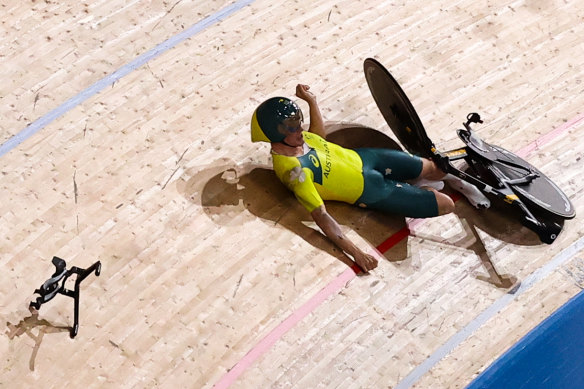
Alex Porter fell heavily during the men’s team pursuit in Tokyo after the handlebars snapped off his bike.Credit: Getty Images
An independent report published in early 2022 found inadequate testing and rushed processes were behind the handlebar fault, and AusCycling apologised to Porter and his fellow athletes. “Innovation can go wrong, and I was brought on to ensure that performance equipment is safe and that we do relevant testing,” says Collins, a former associate professor in design and product development at Deakin University who has previously designed and manufactured for Speedo, lululemon, Quiksilver, Ford and the World Solar Challenge. “I’m big on process development and ensuring that whatever we put into field of play works.”
So how long does process development take for, say, new handlebars?
“You can do really short, fast practical testing or, typically for Olympic cycle, you take a longer view,” Collins says. “You’ve generally got about three years because everything has to be done 12 months out, so right now we’re already having conversations about what the next cycle looks like.” That entails monitoring results in Paris, then working out which of Australia’s athletes might still be in the system come Los Angeles 2028 and which events – and therefore which handlebars – they will target.
Then digital design begins, then computation flow dynamics, and after that prototyping and wind-tunnel testing. Then track-level equipment is produced and tested under strict safety protocols. Only after that is the equipment used in the field of play. Collins says the fastest process from ideation to product output is nine to 12 months. Given AusCycling covers able-bodied and para-cycling on both track and road, and other disciplines such as BMX, multiple projects are usually under way concurrently.
The key, before any of this even starts, is identifying gaps between Australia’s athletes and those from rival nations, and ascertaining whether the deficit is aero or physiological.
“Generally, it’s a combination of both,” says Collins. “Because athletes can always be stronger and fitter and optimise their weight.” That isn’t straightforward, given teams don’t have access to opponents’ heart rate and muscle mass numbers.
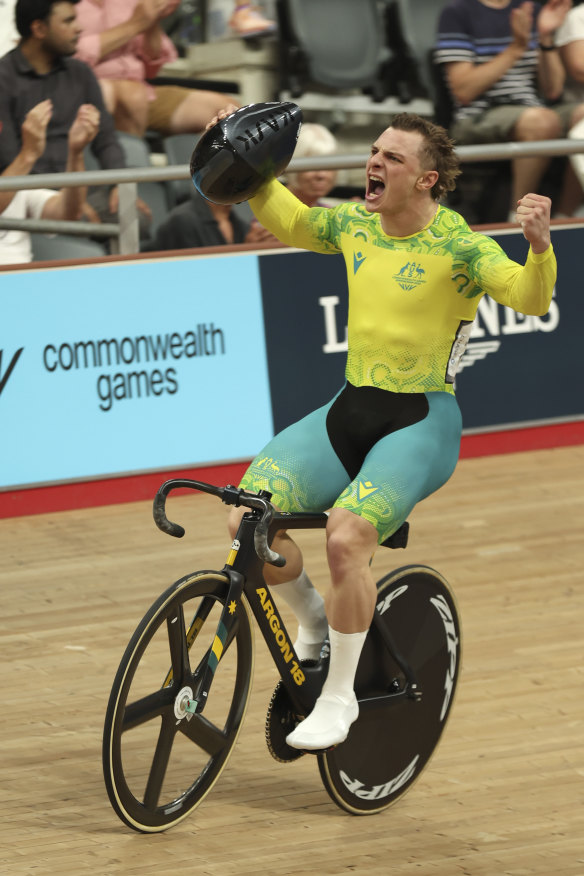
Matthew Richardson, of Australia, celebrates after winning the men’s sprint finals at the Commonwealth Games in 2022.Credit: AP
The answer is AIS data scientists, who undertake regression analysis to understand an opponent’s CdA, or coefficient of aerodynamic drag – the amount of energy a cyclist produces towards overcoming various forces such as wind resistance, gravity and different forms of friction. The lower a rider’s CdA, the more aerodynamic they are. From this, data scientists can make extrapolations about their level of power, and how many watts of that power has come from the athlete and how much from the equipment. “This huge engine of numbers behind every sport,” Collins says. “We have a big database of every event over the last decade.”
This combination of physiological and aerodynamic power highlights possibly the most critical element of success: the rider’s capacity to adopt a riding technique suited to the type of equipment they are using, and adapt accordingly whenever that equipment is updated. It was a special baptism of fire for Richardson, a former gymnast who relied solely on physical and technical strength and then, after an elbow injury, took up cycling and found himself in a different world entirely. It has taken the best part of a decade for “all the pieces of the jigsaw puzzle to start to come together”.
“On a bike, you are the biggest thing in your way,” he says. “The bike is slim, it’s streamlined, it’s aerodynamic. Your body on the bicycle is literally the most drag, so the most aerodynamic gain you can find is by improving your position on the bicycle. If you either get lower or more tucked in, you go faster and improve your CdA. The bike is only 10 per cent of the overall drag. So if you make a 10 per cent gain on the bike – which sounds like a massive amount – you’ve actually only made a 1 per cent gain on the overall drag. Changing your position, or how you hold yourself on the bike, is basically everything.”
This is further complicated when catering for a team. “Because you’ve also got to be catering for the individual, their bodies and their relative speeds,” says Collins. “So what works for Richo [Richardson] and Matt Glaetzer doesn’t work for Grace Brown at all.”
These factors are arguably even more important this Olympic cycle, given countries such as Denmark, Italy and New Zealand have caught up to the traditional heavyweights and continued to push the envelope. At Tokyo 2020, the Danish men’s team pursuit squad sparked heated controversy by wearing strips of fabric tape up the front of their shins. Boardman picked up on it while commentating for the BBC, and rival teams soon complained the tape was almost certainly applied for aerodynamic purposes. The UCI judged it to be against technical rules, in a saga later dubbed #shingate that highlighted the continued search for regulatory grey areas.
Just about every pocket of room to move has been occupied, to the point that Richardson believes “this Olympics will be the closest it’s ever been”.
“The gap is significantly closing, if not already closed,” he says. “Having good equipment for the Olympics basically just keeps you on an even playing field. It’s no longer about having an advantage over others; it’s more making sure you are not disadvantaged.”
McCulloch agrees. “With the rules and the regulations now, we’re not going to see massive changes or gaps in terms of what countries can present for an Olympic kit,” she says. “In Beijing and London, the technology difference was really quite large. GB just had a superior package to everyone else because they had invested in that R&I and innovated their equipment.
“The world has caught up now, and I think that we’ll find that bikes will look relatively similar unless the UCI changes the rules and regulations and you can do whatever you want. So what will become really important again is training mindset, performance psychology and the quality of coaching. Those things are going to start to play a bigger role than tech as we move into the next cycle or two.”
Team GB have already made a strategic move in this area. A year after Tokyo, having won only half as many golds as in Beijing, London and Rio, the team completely overhauled their fleet of senior track coaches, bringing in Ben Greenwood and Cameron Meyer to head up the men’s and women’s endurance programs, and Jason Kenny and McCulloch the sprint programs.
McCulloch, who oversaw the rise of Emma Finucane to sprint world champion, moved back to Australia late last year to be closer to family. The 36-year-old has taken up a position as the Queensland Academy of Sport’s sprint coach, along with a longer-term nationwide role in developing the Australian women’s team sprint ahead of Los Angeles 2028 and Brisbane 2032. She is in Paris as one of Australia’s deputy chefs de mission under former Olympic teammate Anna Meares. All the while, she’ll be keeping a close eye on the British competition.
“GB are pushing the boundaries in that space, with quite young [faces] in terms of coaching careers, and I think that brought a breath of fresh air into that program,” McCulloch says. “So it wouldn’t surprise me if they are quite successful this cycle because they’re ahead of the game again in terms of the next thing to shape the Olympic cycle.”
Sign up for our Sports Newsletter to get Olympic Games updates and general sport news, results and expert analysis straight to your inbox.